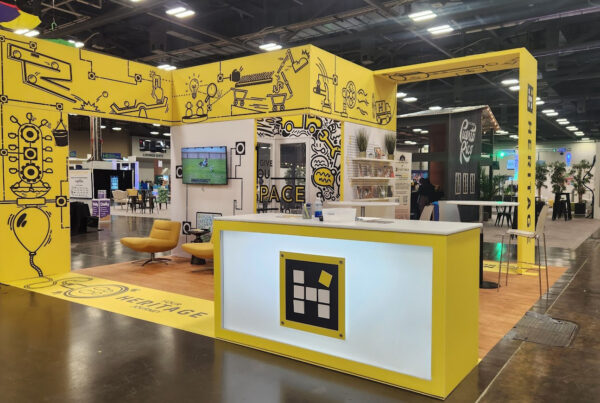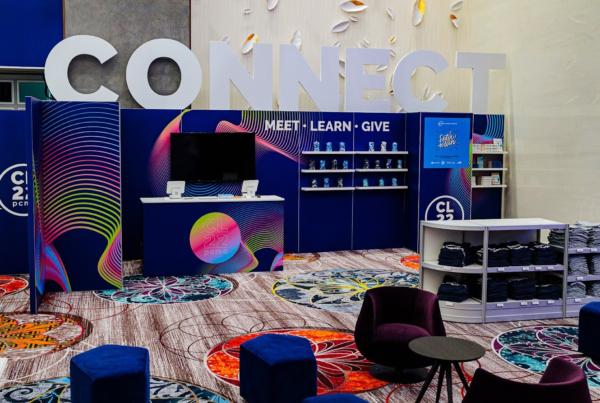In the world of event planning, COVID-19 taught us how virtual events could serve as a placeholder for in-person gatherings. However, now that live events are once again taking place, we are seeing the benefits of hybrid events, that is, events that combine both in-person and virtual experiences.
Due to their potential for increased reach and sponsorship opportunities––not to mention greater flexibility for attendees––hybrid events are becoming the new normal. With that said, hosting a successful hybrid event requires more than simply live streaming in-person sessions; rather, it demands seamless integration of technology with the in-person experience.
If you’re planning your first hybrid event or trade show, here are tips that will help you stand out from the rest.
1. Create a Unique Experience for Online and In-Person Attendees
As with planning any event, your goal is to create value for your attendees. When creating a hybrid experience, you’ll want to ensure that both virtual and in-person attendees have similar benefits. This starts with engagement.
Even with live events, it can be difficult to remain focused; this applies doubly to virtual events, where attention can quickly switch to another window on one’s screen. That’s why it’s important to make sure that virtual attendees can participate in discussions, ask questions, or even respond to polls. By providing your virtual crowd with features normally reserved for in-person settings, you can help increase their participation––even from afar.
Integrate Virtual and Physical Components
To begin integrating virtual and physical components of your event, you’ll want to consider your overall goals as an organization. Perhaps you want to increase your reach in the industry or cement your company as an authority in the space. You should also consider what benefits matter most to attendees. Are they hoping to network, find new clients, or learn new strategies in the field?
For example, if finding new clients is a primary objective for attendees, you might consider incorporating virtual booths. Using these, in-person attendees can hold digital conversations with remote attendees, creating an experience similar to breakout sessions. There are several third-party platforms available specifically for this, or you can build this into your app with the integration of several video chat platforms.
2. Rehearse the Event or Trade Show
Whether through an office Zoom call or a virtual conference, we’ve all experienced the second-hand embarrassment that comes with technical glitches. When staging your virtual event, the last thing you want is faulty video, audio, or other technical elements to hamper the experience.
Additionally, it’s possible the content you have planned doesn’t resonate virtually. The only way to truly know this is to stage a full run-through with staff that includes stand in virtual attendees. This will allow you to address any technical or content-related issues before the actual event.
Check Your Connection
With seamless engagement being of the utmost importance, your hybrid event requires a solid internet connection. One with insufficient speeds could quickly ruin the experience for virtual attendees. Check and double-check connectivity.
3. Have a Contingency Plan
Even when your equipment has been thoroughly checked, something can (and likely will) go wrong on the day of your event. This is why it’s important to create a backup plan for not only online issues but also in-person technical issues.
Each component of your event––speakers, videography, electric, etc.––should have a backup plan in place. You should also designate particular staff to each of these elements, ensuring that a chain of command is in place to address issues as they arise.
4. Include Virtual Elements
Another way to increase engagement with virtual attendees is to create elements specifically for them. In addition to virtual polls and Q&A forums––both of which emulate the in-person elements––you might also consider:
- Virtual happy hours can simulate the more casual networking opportunities of your event.
- Virtual sessions for more intimate interactions with speakers and hosts.
5. Expand Your Sponsorship Packages
A major bonus of offering a hybrid event is that it expands your reach to near-infinite possibilities––something that can be extremely attractive for sponsors. Additionally, hybrid events diversify the sponsorship opportunities to include either virtual sponsorship, in-person sponsorship, or both.
For example, a sponsor could opt to be featured at the event itself on signage or leaflets. Alternatively, a sponsor could also be featured on apps or banners that remain at the bottom of the screen during certain virtual sessions.
Digital sponsorships also allow for more accurate lead tracking allowing them to better understand their return on investment. This can help future participation.
6. Uplevel Your Set Up
As with any event, its success is rooted in the planning and setup. Lighting, staging, audio, and the successful execution of hybrid components all contribute to a seamless experience for attendees. That’s why you should consider partnering with a team of experts.
With over 60 years in the trade show and convention industry, Heritage Nationwide Exposition Services is an essential partner for event planning. Whether you’re planning your first conference, or you’re looking to optimize an existing show, Heritage can help your association adapt to and excel in the changing landscape of hybrid events.
An asset-based contractor, Heritage owns all their equipment and can work with your team to determine the best setup for your needs. With quick turnaround times and cutting-edge technology, Heritage can guide you through every step of the event planning process, ensuring that your trade show meets the needs of a rapidly evolving industry.





